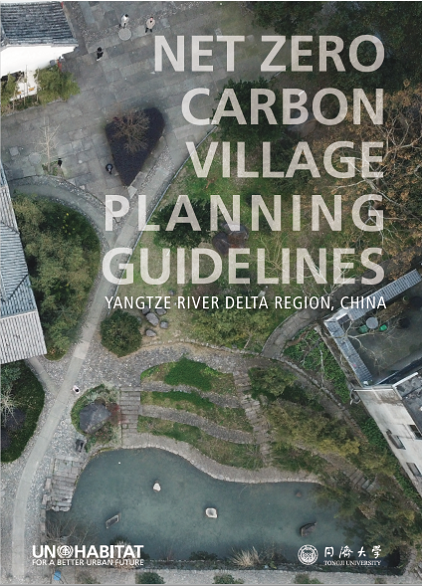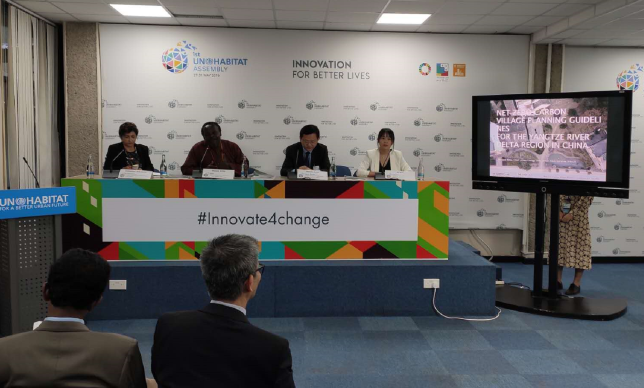Search

NAIROBI, Kenya, 23 May 2019 / UN-Habitat launches the publication of Net Zero Carbon Village Planning Guidelines for the Yangtze River Delta Region in China at an official launch event from 18:00-19:30 in the Press Room at UN-Habitat’s Headquarters in Nairobi on Monday, 27 May during the first session of the UN-Habitat Assembly.
[The Guidelines are the result of a collaboration between Tongji University and UN-Habitat. The research is part of a wider project supported by the Commission of Science and Technology of Shanghai Municipality, in partnership with Tongji University, as well as Shanghai Research Institute of Building Sciences and Shanghai Academy of Environmental Sciences.]

Nearly 90% of the 3.4 billion people living in rural areas reside in Africa and Asia[1]. In 2014, China alone was home to 635 million rural residents[2]. However, by 2050 approximately half of China’s current rural population will become urban, a net loss of around 300 million people in rural areas[3]. At the same time, China’s State Council approved a plan that aims to transform the Yangtze River Delta region—alongside the Pearl River Delta and the Beijing-Tianjin-Hebei region—into a “world-class city cluster” by 2030[4]. The aim is for these world-class clusters, in contrast to 16 medium- and small-sized clusters, to be the economic power-houses of China, capitalizing on innovative and internationally competitive industries[5].
This demographic paradox leaves the fate of villages in the Yangtze River Delta somewhat unknown. Yet the region faces simultaneous unprecedented risks to its natural and urban environments. The inherent vulnerability of this highly valued eco-system and agricultural region due to the large concentration of neighbouring metropolitan areas, its economically strategic position along major shipping lanes and manufacturing hubs as well as the interlinked conflict between social and economic development and environmental conservation, needs to be addressed. These conditions make it, with time, increasingly harder to govern urban and rural settlements resulting in lost opportunities for sound economic growth that respects strong ecological balance.
This challenging context is not only relevant to the YRD region but also to other Chinese and international regions where connectivity could be enhanced through rural and urban linkages, which is especially pertinent since 2007, when more than half of the world’s population lives in cities.
Net Zero Carbon Village Planning Guidelines address these complexities, developing an approach that aims to build upon normative research on climate resilient, energy and resource efficient planning principles in order to develop tools for the development of net-zero carbon village guidelines.
CHAPTER ONE examines the net-zero carbon village from a global perspective, shifting the notion of zero carbon planning from a focus on carbon accounting, to a focus on circular metabolisms and economies.
CHAPTER TWO outlines guiding principles for local governments and partners to adopt in order to direct development towards sustainable outcomes. The guidelines build on the current situation in the Yangtze River Delta region—which includes Shanghai, northern Zhejiang Province, southern Jiangsu Province, and eastern Anhui Province—and aim to look beyond merely the green and low carbon features of a single building, by extending low carbon principles to villages and their surroundings.
CHAPTER THREE presents the status quo of three villages in the YRD region and makes design recommendations which demonstrate how net-zero carbon principles can be implemented in Shanghai, Zhejiang and Jiangsu.
CHAPTER FOUR focuses on Xiebei Village—adjacent to Shanghai on Chongming Island—and presents a more detailed methodology for how net-zero carbon village development principles can be spatially integrated into a village through the development of a conceptual plan.

Collectively, these four chapters introduce the global and historical relevance of net-zero carbon planning, set 10 principles for its application in the YRD region in China, and demonstrate how those guidelines could be integrated into existing village contexts. Through a two-fold objective, the guidelines can be used to help standardize and codify ecological planning principles for villages in the Yangtze River Delta and set an example of net-zero carbon planning strategies that can be scaled up and replicated in other relevant towns at the national and international level.
[1] The World Bank. (2018). Retrieved from https://data.worldbank.org/indicator/SP.RUR.TOTL.ZS?locations=CN
[2] Ibid.
[3] Ibid.
[4] Mark Preen. (2018). China’s City Clusters: The Plan to Develop 19 Super-regions. Retrieved from https://www.china-briefing.com/news/chinas-city-clusters-plan-to-transform-into-19-super-regions/
[5] Stephen P Groff, Stefan Rau. (2018). City clusters can succeed in China. Retrieved from https://www.telegraph.co.uk/china-watch/society/urban-planning/



